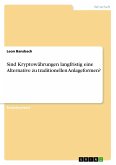Bachelor Thesis from the year 2011 in the subject Business economics - Investment and Finance, University of Applied Sciences Essen, language: English, abstract: This study aims to integrate itself into the scientific network of business administration by covering the topic of dividend strategies. Its main objective is to give a theoretical overview on the field of dividend orientated investment strategies under consideration of current scientific literature and research results. Additionally, a practical part is included as the study also applies the theoretical findings empirically by examining a possible outperformance of investment strategies on the German stock market.Chapter 2 creates the basis as it explains the differences between passive andactive portfolio management under consideration of the market efficiencyhypothesis. As the active management style contains several differentapproaches, it is divided in three main categories that are linked to differentstages of market efficiency. Due to the fact that dividend strategies aim tooutperform the market, they are assigned to semi-active and active portfoliostrategies. To get informed about different possibilities of measuring thisoutperformance, the chapter finishes with a presentation of performanceanalysis concepts that complement each other. Chapter 3 goes more intodetails of dividend strategies as it divides them into two basic categories. As the active ones are partly complex and require the estimation of a company's future growth rate, they are preferably used by institutional investors. In contrast to that, the semi-active dividend strategies can be easily applied also by individual investors as they are linked to objective and clearly defined actual figures. Moreover, a large number of investment opportunities have been developed and issued in the last years that make it easy to follow those dividend strategies. To get an overview on the state of research, several empirical studies concerning the success of dividend strategies on different markets are presented. The last chapter 4 contains an empirical study on the German stock market, which examines the advantageousness of the DivDAX in comparison to the DAX over a time frame of 11 years. After an interpretation of the results, combined with an outlook on possible future research questions, a general conclusion of the theoretical and practical part is made in chapter 5.








